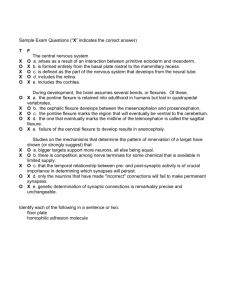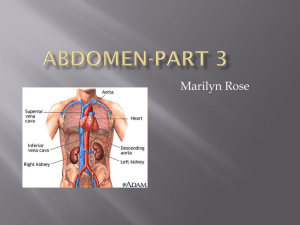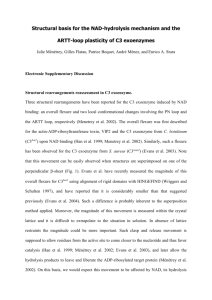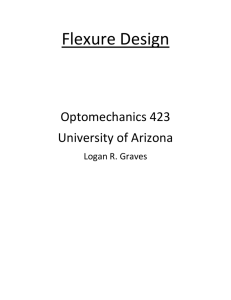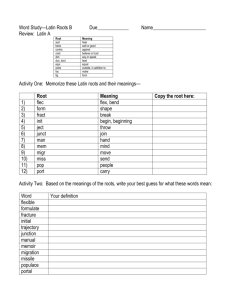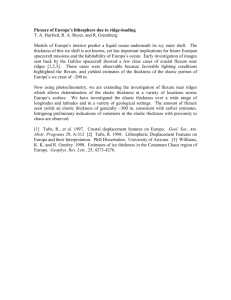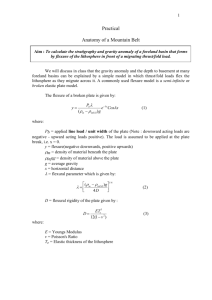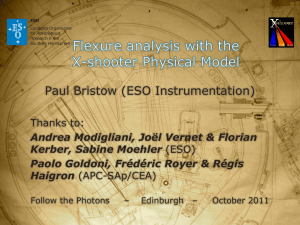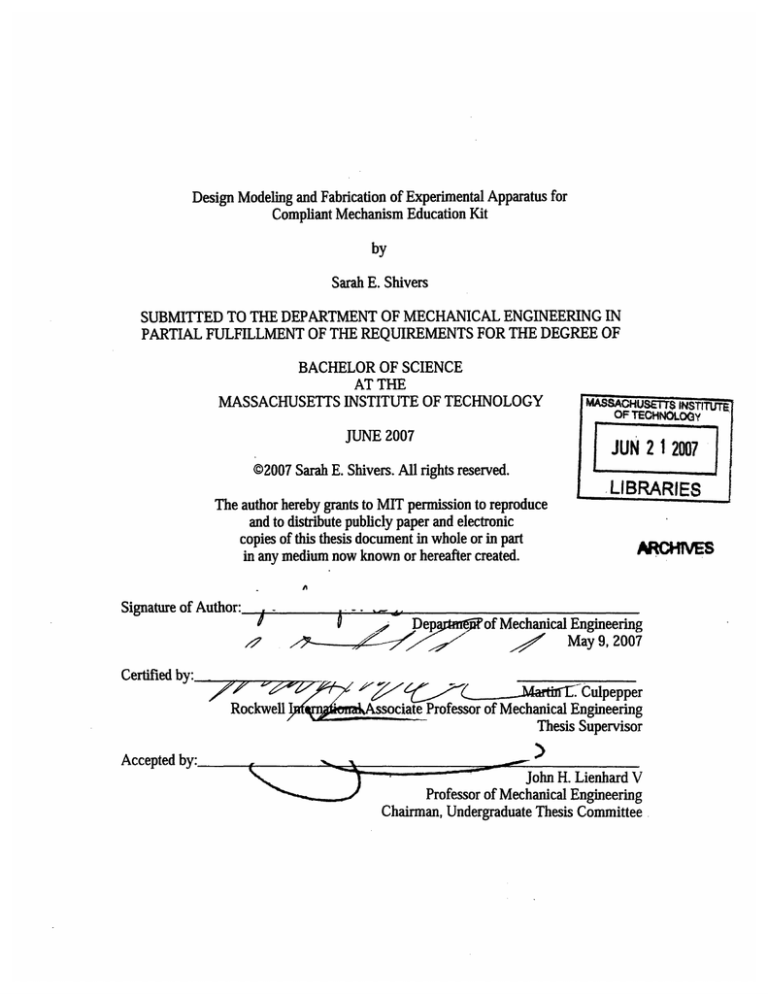
Design Modeling and Fabrication of Experimental Apparatus for
Compliant Mechanism Education Kit
by
Sarah E. Shivers
SUBMITTED TO THE DEPARTMENT OF MECHANICAL ENGINEERING IN
PARTIAL FULFILLMENT OF THE REQUIREMENTS FOR THE DEGREE OF
BACHELOR OF SCIENCE
AT THE
MASSACHUSETTS INSTITUTE OF TECHNOLOGY
JUNE 2007
MASSACHUSET
INSTITUTE
OF TECHNOLOGY
JUN 2 12007
@2007 Sarah E. Shivers. All rights reserved.
The author hereby grants to MIT permission to reproduce
and to distribute publicly paper and electronic
copies of this thesis document in whole or in part
in any medium now known or hereafter created.
Signature of Author:
I
/
'9
Certified by:
'00000
Rockwell IW
· _ _ _)
0
..
Dep
LIBRARIES
ARCHMES
of Mechanical Engineering
May 9,2007
,/
pepper
.Culpepper
'
livna4
Associate Professor of Mechanical Engineering
Thesis Supervisor
Accepted by :
_
John H. Lienhard V
Professor of Mechanical Engineering
Chairman, Undergraduate Thesis Committee
Design Modeling and Fabrication of Experimental Apparatus for
Compliant Mechanism Education Kit
by
Sarah E. Shivers
Submitted to the Department of Mechanical Engineering on May 9, 2007 in Partial
Fulfillment of the Requirements for the Degree of Bachelor of Science in Mechanical
Engineering
ABSTRACT
The purpose of this thesis is to design an educational kit to be used to teach practicing
engineers about recent developments in the study and design of flexures. Flexure theory
can be difficult to explain. This kit is a physical example of the FACT method for
designing flexures. The first flexure is a linear motion flexure, which is a familiar design
to practicing precision engineers. The second design is a flexure which moves in a screw
motion, which has never been built before. The design of the screw flexure uses the
FACT method to combine constraints to create a linked linear and rotational motion. The
screw flexure is also designed to have a variable pitch, such that it ranges from pure
rotational motion to linear motion.
This thesis contains the modeling, design, and fabrication process for both the linear and
screw flexure. Two working prototypes were manufactured of each flexure. They are
assembled on a baseplate and include sensors to measure the motion of each flexure. One
kit was used to explain the concepts behind the design of the flexures to two students.
They were then able to answer a few questions about the concepts after experimenting
with the flexures.
Thesis Supervisor: Martin L. Culpepper
Title: Rockwell International Associate Professor of Mechanical Engineering
ACKNOWLEDGEMENTS
I would like to thank the people who helped make this thesis possible. I would first like to
thank Professor Martin Culpepper for overseeing the project and providing many
suggestions.
I would also like to thank Holly Laird for keeping me on track and ordering all the parts.
She is a great thesis partner and I really could not have done it without her.
Thank you also to Jon Hopkins for answering both Holly and my questions and e-mails.
He explained everything from the beginning and helped us all the way through.
Finally thank you to Gerald Wentworth and Patrick McAtamney in the LMP shop for all
their help with manufacturing the flexure systems.
Table of contents
Abstract ...............................................................................................................................
3
Acknowledgem ents.....................................................................................................
5
Table of Contents .......................................................................................................
7
Table of Figures ..........................................................................................................
9
Chapter 1 Introduction ......................................................................................................
11
Chapter 2 Design and Manufacturing of Linear Flexure ......................................
17
2.1 Design of linear flexure .....................................
....................... 18
2.2 Fabrication of linear flexure................................................
Chapter 3 Design and M anufacturing .....................................
19
...................21
3.1 Outer structure with triangular supports .....................................
..... .. 24
3.2 Inner structure with Z-shaped support ........................................... ... 28
Chapter 4 Experimental Setup and Sample Testing .....................................
Chapter 5 Results and Analysis ...........................................................
5.1 Testing Results..............................................
..... . 31
....................... 33
................................................ 33
5.2 Analysis............................................................................................................... 33
Chapter 6 Conclusion........................................................................................................ 35
6.1 Sum mary............................................................................................................. 35
6.2 Future Work .....................................................................
References
..........................................
............................. 36
37
Appendix A W orksheet..................................................................................................... 39
Appendix B Survey Questions........................................ ............................................ 41
7
Table of Figures
Figure 1-1: Linear Motion Flexure ...................................................
Figure 1-2: Screw Motion Flexure.............................
12
................... 12
.......
Figure 1-3: Two constraint models with the same degrees of freedom ............................ 13
Figure 1-4: Illustration of pitch on flexure system with screw motion......................... 15
Figure 2-1: Linear Motion Flexure Solid Model ......................................
....... 17
Figure 2-2: CosmosWorks FEA displacement analysis on linear flexure .................... 18
Figure 3-1: Flexure system with screw-like motion solid model solid model.................. 21
Figure 3-2: First design iteration of Flexure system ........................................
...... 22
Figure 3-3: Flexure system solid model, exploded view ......................................
Figure 3-4: Triangle support for Flexure system ....................................
23
........ 24
Figure 3-5: CosmosWorks FEA displacement analysis on triangle support ................ 25
Figure 3-6: Base of triangle support for flexure system .......................................
26
Figure 3-7: Top of triangle support for flexure system...............................
...... 27
Figure 3-8: Z-shaped support for flexure system................................
.......... 28
Figure 3-9: CosmosWorks FEA displacement analysis on Z-shaped support.............. 29
Figure 3-10: Bottom of Z-shaped support for flexure system .................................... 30
Figure 3-11: Top of Z-shaped support for flexure system .........
.....................
............ 30
Chapter 1
Introduction
The purpose of this thesis is to generate the knowledge required to design and
fabricate a flexure with linear motion and a flexure with linked linear and rotational, or
screw, motion to be used in educational kits. The theory behind such flexures can be
difficult to explain. These kits will be used in presentations to practicing engineers
involving advances in the study and design of flexures. The educational kits will give the
engineers the opportunity to explore and perform experiments related to concepts that
they are unfamiliar with and ultimately give them a better understanding. They can then
take this knowledge back to their respective careers to use it in designing flexures.
Ideally, they will be able to design flexures that are better suited for various purposes at a
cheaper cost. This saving can then be felt by the consumers. Many consumer products
use flexures in their design, such as products that contain switches, engines, gear drives,
and circuit boards to name a few. The design cars, toys, computers, and countless other
products that use these design features could benefit from advanced knowledge in the
design of flexures.
The design of each flexure is explained within this thesis, with more emphasis put
on the flexure with screw-like motion, which is the more complicated of the two. The
linear flexure, seen in Figure 1-1, serves as an example of a flexure that is somewhat
common, and the flexure seen in Figure 1-2 has never been built before. The educational
kits will include sensors to measure the linear and rotational motion of the flexures as
well as the force required to move them.
Figure 1-1: Linear Motion Flexure
Figure 1-2: Screw Motion Flexure
The theory used in this thesis regarding the design and study of flexures is based
on the work of Douglass L. Blanding. In his work, he uses the following equation
showing that the number of degrees of freedom in a flexure is related to the number of
non-redundant constraints such that
6-C=R
where C is the number of non-redundant constraints and R is the number of degrees of
freedom. Furthermore, each degree of freedom must intersect with each constraint
(Blanding, 37). Blanding explains that
An intersecting pair of Cs or Rs defines a disk of radial lines any two of
which (provided the angle between them is not too small) may be
selected to equivalently replace the original pair (for small motions). [1]
In his book, Blanding uses cubes to illustrate this. Figure 1-3 shows that the degrees of
freedom are the same for two separate sets of constraints. However, the constraints are
linked, as each constraint is still in the same plane as before. In the illustration, the solid
lines are the constraint lines and the freedom lines are illustrated with dashed lines and
arrows.
Figure 1-3: Two constraint models with the same degrees of freedom
There have been new developments in this field. MIT graduate student Jonathan
Hopkins' research has found that the constraints need not only be in the same plane to
produce the same degrees of freedom, but other topologies as well. His work with
Freedom and Constraint Topologies, or FACT, shows there are other shapes beyond the
disks that Blanding uses. Degrees of freedom can occur in disks, planes, spheres,
hyperbolic paraboloids and hyperboloids. Constraints can occur in disks, planes, boxes,
spheres, or lines. There are six different cases for the different numbers of degrees of
freedom and constraints, beginning with no constraints and complete free motion ranging
to six constraints and no motion. Each set of constraint shapes is unique to a set of
freedom shapes. There are twenty-six cases total. In some cases, there is a screw motion,
which is demonstrated in the screw flexure.
The screw flexure is designed to have a pitch that can be varied throughout
experimentation. Pitch is the distance that a screw moves linearly. In this case, the pitch
is dependant upon the distance that the z-shaped constraint is from the middle of the
flexure and the angle of the Z from the base. The specific relationship is
p = d tan 9
This is illustrated on the flexure system in Figure 1-4.
Figure 1-4: Illustration of pitch on flexure system with screw motion
The angle of the Z, 9, is set, so only the distance can be varied to vary the pitch. Those
using the kit can use this relationship when adjusting the flexure to obtain data for
different pitches, from pure rotation when the z-piece is set in the middle of the flexure,
to near pure linear motion. Pure linear motion occurs when the distance is equal to
infinity, but this is obviously impossible. However, at the farthest setting, the pitch is
high enough that, given the relatively small motion of the screw flexure, the motion may
be considered to be just linear.
This thesis will detail the design and manufacture of both the linear flexure
system and the flexure with linked rotational and linear motion, as well as the entire
experimental setup and the testing of the educational kits on fellow students to see what
they learned. The second chapter will begin with the design and manufacturing of the
linear flexure. The third chapter will contain details involving the design and
manufacture of the flexure system with screw-like motion. This flexure system will be
covered in greater depth as it is much more complex than the linear flexure system. The
third chapter will discuss the experimental setup and the various sensors involved, as well
as the design of the baseplate and support system for these sensors relative to the
flexures. The fourth chapter will describe the testing of the educational kit with the screw
flexure. Finally, chapters five and six will cover the results, analysis and conclusion.
Chapter 2
Design and Manufacturing of Linear Flexure
The linear flexure system is a common design. The key is having two separate set
of thin flexures to oppose any arc motion. With only one set of flexures, the flexure
system will move in an arc downward as it moves linearly. However, with two sets of
thin flexures, the middle block is restrained and the force is applied to the bottom block
not connected to the middle block. Then, the top block moves in a downward arc as the
bottom block moves in an upward arc. The two motions oppose each other and the
flexure moves linearly. The two sets of flexures need to be identical to accurately oppose
the motion.
Figure 2-1: Linear Motion Flexure Solid Model
2.1 Design of linear flexure
To determine the dimensions of the flexure, the thin flexures are modeled as
cantilever beams. Therefore, the stiffness, k is dependent upon the thickness of the
flexure in the direction of intended motion cubed. They need to be thin in the direction of
motion. However, the thickness in the direction perpendicular to the intended motion,
but in the same plane, is needed to prevent buckling. ComosWorks finite element
analysis is then used to test the numbers determined by the cantilever beam model. One
of the functional requirements of the linear flexure system is that the linear motion is
clearly visible, or approximately one inch of linear motion for one pound of force.
CosmosWorks FEA is also used to test for buckling.
UX (i)
-9.074e-002
.1.210"011
-1.8 5·1e-OO1
-2.118e-001
-2.4.206001
ý2.7238-001
-3.025e-00i
-3.328ec001
Figure 2-2: CosmosWorks FEA displacement analysis on linear flexure
2.2 Fabrication of linear flexure
The linear flexure system is made of 19.05 mm [0.75 in] Delrin. The thickness is
determined by the thickness perpendicular to the intended direction of motion. The
waterjet is then used to cut out the design of the flexure. The waterjet works well for this
design, as all the cutting is in one direction. To transfer the design to the waterjet
computer, the solid model is made into a drawing which is then opened in OMAX, where
starting and ending points are determined and a cutting path is drawn. The file can then
be opened on the waterjet computer and the part can be made.
Chapter 3
Design and Manufacturing
The flexure system, shown in Figure 3-1, is made of seven unique parts. The only
pieces that are symmetric are the triangular support pieces. The design of each piece will
be described in this chapter, as well as manufacturing details. The entire flexure is made
of Delrin, but the thicknesses vary with the parts. The inner structure with the Z-shaped
support is independent of the outer structure with the triangular supports. The Z-structure
determines the pitch of the screw-like motion of the flexure system. The pitch may be
adjusted by moving the Z-structure.
Figure 3-1: Flexure system with screw-like motion solid model solid model
Figure 3-2: First design iteration of Flexure system
In the first design, shown in Figure 3-2, the different parts were essentially the
same as those shown in Figure 3-1. The main difference was that the parts were
connected with tabs fitting in to slots. The triangular and Z-shaped supports had tabs at
either end that fit into slots into their respective base and top. This was determined to be
too difficult to manufacture given the level of accuracy needed in the design of the slots.
For the tabs to stay in the slots, they would need to be press-fit. However, one of the
design requirements was that the flexure be easily assembled and disassembled. Press-fit
tabs and slots would prevent this. Another problem with the design is the extended base
and top of the Z-shaped support. For most settings, part of them would be hanging over
the edge of the base of the triangular shaped supports, which could cause the flexure to be
off-balance. There is also a stop at one end to prevent the Z-shaped support from going
out of one end. This was also attached with a tab and slot in the triangular shaped base
and top.
Figure 3-3: Flexure system solid model, exploded view
These design problems were adjusted in the next design, shown in exploded view
in Figure 3-3. The triangular and Z-shaped supports are bolted to the outside of their
respective base and top, eliminating the tabs and slots. This allows the flexure to be easily
assembled and disassembled for transportation. Another adjustment on the second design
is the base and top for the Z-shaped support is half the size of those in the original design.
This way, it stays contained within the triangle support structure. A third change to this
design is that the mechanical stop is removed. In the second design, the base of the
triangular supports is bolted to a larger base plate. The heads of the screws serve as a
mechanical stop in themselves, so there is no need an entirely different part. The
individual pieces of the second design are pictured below with descriptions as to their
individual functions.
3.1 Outer structure with triangular supports
The outer structure needs to be self-supporting, but the triangular shaped supports
need to be thin enough to serve as flexures. Most of the modeling surrounds the
triangular supports, shown in Figure 3-6. The design of the base and top were then
designed base on the dimensions of the triangular supports.
Figure 3-4: Triangle support for flexure system
Before modeling the triangular supports, it was decided to simplify the model.
The width and thickness of the thin parts of the support would be the same. This way,
only two dimensions needed to be determined independent of each other, the thickness
and the length. It was difficult to account for both the linear and rotational motion in a
model, so FEA analysis in CosmosWorks was used to determine the stress and
displacement for various values of thickness and length, shown in Figure 3-5.
LREgS
(in)
...
0394em001.
7,694e-M9
.6.2956-001
S.Swen-001
4.8960-Mn
4.1976-M:~l
3.4.97e-001
2.7900-001
2.098e-00
t.3gftwM
6.9950-002
3.9370-032
Figure 3-5: CosmosWorks FEA displacement analysis on triangle support
The entire flexure system was too large to run an FEA analysis, so the triangular and Zshaped supports were tested independently. Initially, the results showed that a thickness
of 3.175 mm [0.125 in] had the best displacement. However, there was concern over
buckling, so that dimension was increased to 6.35 mm [0.25 in]. The length was then
increased from 190.5 mm [7.5 in] to 215.9 mm [8.5 in] to regain some of the flexibility.
There are four holes for 9.525 mm [0.375 in] bolts to attach the triangular supports to the
base and top. The height of the top and bottom of the triangular flexures is designed to
extend past the base and top so that they can serve as guides for the Z-support structure.
For manufacturing, the parts were cut on the waterjet out of 6.35 mm [0.25 in] thick
Delrin.
Figure 3-6: Base of triangle support for flexure system
The bottom of the triangular support structure has several functions besides
simply a base for the triangular supports. The slots in the middle serve as a measurement
when changing the pitch. The seven slots are each 12.7mm [0.5in] apart. They can be
used to determine the distance from the center, d, when calculating the pitch of the
flexure. There are also four 9.525mm [0.375in] holes to be used to attach the structure to
a larger base plate. The slots, holes and main shape of the base were cut on the waterjet
out of 19.05mm [0.75in] thick Delrin. The four 9.525mm [0.375in] holes on each side
are to attach the triangular supports. They were drilled on a mill and then tapped using
the same mill to power tap the holes. Finally, there are slots milled for 3.175mm
[0.125in] steel shim stock which will be used for the magnets in the Z-support structure
to slide on.
Figure 3-7: Top of triangle support for flexure system
The top piece of the triangular support structure has the same outer dimensions as
the bottom piece. It also has the same 9.525mm [0.375in] holes on both the top and the
sides and was manufactured in the same way. The only difference is the middle. Instead
of slots to measure the distance from the center, the center is a hole with points in the
center to keep track of what slot marker the Z-support structure is lined up with. Initially,
the top and bottom pieces were to be the same, both having these holes and the bottom
and top of the Z-support structure would have the measurement slots. However, then the
design was changed such that the flexure system would be bolted to a larger base plate,
so it would be impossible to flip the flexure over to line up both the top and bottom of the
Z-support structure. For this reason, the design was changed so the bottom of the
triangular support structure was changed to have the measurement slots. The top still has
the hole so that the user can see to adjust the Z-support flexure. The hole and basic shape
of the top of the triangular support flexure were cut on the waterjet.
3.2 Inner structure with Z-shaped support
Without the inner structure, the outer structure would just be a linear flexure, for
small movements. It is the added constraint inthe Z-shaped support that causes the
rotational motion.
Figure 3-8: Z-shaped support for flexure system
The Z-shaped support was designed to have the same thickness and width as those
in the triangular supports. The length of the Z-support is also determined by the length of
the triangular flexures, as the Z-support flexure needs to fit within the triangular support
structure. Like the triangular support, the Z-support was analyzed with CosmosWorks
FEA software to test the displacement and stresses, as shown in Figure 3-9.
;
URES (in)
I8.938e-M
I.073e+000
9.8318-001
.8.044e-001
7.150e-O0
6~256e-001
5.363e&I0
4A69e-ý00
3.575e-001
2.881e.01
I.788e-00i
8.938e-002
3.937e.032
Figure 3-9: CosmosWorks FEA displacement analysis on Z-shaped support
The angle of the diagonal of the Z was set to approximately 71.570, the tangent of
which is equal to three. Therefore, when determining the pitch, the equation for this
flexure is simplified to p = 3d. Finally, there are four 6.35mm [0.25in] holes in the top
and bottom of the Z-support to allow it to be bolted to the base and top. The entire Zsupport was cut on the waterjet from 6.35mm [0.25in] thick Delrin.
The bottom and top of the Z-support structure are similar in design to the bottom
and top of the triangular support structure, only they are inverted. For this structure, the
bottom, shown in Figure 3-10, has the whole with the arrows and the top, shown in
Figure 3-11, has the measuring slots. The parts were also cut on the waterjet as well. The
main difference, besides the size, which was explained earlier in this chapter, is that,
instead of slots for steel stock, there are holes for magnets. These holes were milled on a
CNC machine so that their placement was easily repeatable. Also, the depth of the holes
was important so that the magnets sat flush against the parts so that they would easily
slide along the steel. Finally, both the top and bottom have four 6.35mm [0.25in] holes
which were drilled and power tapped to allow easy assembly with the Z-shaped support.
Figure 3-10: Bottom of Z-shaped support for flexure system
Figure 3-11: Top of Z-shaped support for flexure system
Chapter 4
Experimental Setup and Sample Testing
Once the flexure systems were designed and built, there needed to be some way to
measure the motion of each system. Holly Laird's thesis consists of selecting sensors to
measure the motion of the flexures as well as the forces required to move them. A linear
potentiometer was selected for the linear flexure and a setup was designed to support the
flexure, linear potentiometer, and force gage, which was used to measure the force
applied to the flexure. For the screw flexure, both linear and rotary potentiometers were
needed to measure the two linked motions. A force gage was also used. The supports for
these sensors may be seen in Figure 1-1.
The purpose of these flexure systems is to be used in educational kits. Therefore,
a test was conducted to see how much someone with a given knowledge of flexures could
learn from them. As the flexure system with screw-like motion is the more complicated
and unfamiliar of the two, it was chosen to be tested. Two MIT seniors in mechanical
engineering that are currently taking 2.72, Mechanical Design volunteered after an e-mail
was sent to the class requesting participants. This class was selected as flexures and
constraints were part of the curriculum, so the students' level of knowledge regarding the
subject was known. They first listened to a presentation describing the flexure system
with screw-like motion and how it worked. Next, they were given a worksheet with
several questions to answer and told they were allowed to experiment with the flexure
system to answer the questions. Some of the questions included determining the pitch for
a given distance as well as determining the distance for a given pitch. For these
questions, they were then asked to calculate the linear and rotational displacement when
the flexure was set for the given pitch and distance. Finally, they were given a survey
regarding how much they learned from the presentation and experimenting with the
flexure.
Chapter 5
Results and Analysis
5.1 Testing Results
Overall, the testing went well. The students asked several questions and seemed
to enjoy working with the flexure system. All their answers were correct on the
worksheet, although there were some technical difficulties with the sensors, such that
they were unable to obtain actual data.
For the survey, they were asked three questions where the answers ranged from
one to five, with five being the highest. The results are as follows.
1) Did you learn anything from the presentation?
Average answer: 3
2) Did you learn anything from experimenting with the screw flexure?
Average answer: 5
3) How well did the flexure demonstrate the concepts discussed?
Average answer: 4
The last two questions asked if anything was unclear or should be presented in a
different manner and left space for comments. Both mentioned that more time could be
spent in the presentation on constraint and freedom lines specifically for flexure systems.
In the comments section, both again requested more emphasis on flexure systems in
general for the presentation.
5.2 Analysis
The results from the survey, specifically questions two and three show that the
students learned from interacting with the flexure system and not just listening to a
lecture. They both circled five for the second question, asking if they learned anything
from experimenting with the flexure system, and one student added "It was fun to play
with." The resulting responses to question three, which asked how well the flexure
demonstrated the concepts discussed, averaged out to four, because one student
responded with a five, while the other circled three. The student who circled three added
that the "screw flexure has 'weird' [degree of freedom] lines" and wished that that issue
would be addressed more in the lecture.
The size of the flexure appears to be another advantage. While most flexures used
in products are very small, the linear and screw flexures are on the order of about eight
inches in height. This allows potential students to easily see what exactly is happening as
the flexure moves. In general, the practicing engineers that the flexure will eventually be
presented to are adults with larger hands, such that were smaller size flexures built, they
would be difficult for them to move and adjust.
Chapter 6
Conclusion
6.1 Summary
This thesis gives the design details for both a familiar linear motion flexure and a
new flexure with screw motion. Both are to be used in educational kits given to practicing
engineers in a class that introduces them to new developments in flexures. The linear
flexure is designed as something they will have seen before and understand the concepts
behind. The flexure system with linked linear and rotational motion is something that
they will have never seen before. Therefore, it is designed in a manner such that they can
experiment with it and adjust the pitch.
This thesis is based on the graduate work of Jonathan Hopkins in the area of
Freedom and Constraint Topologies, which builds on the work of Douglas L. Blanding.
Blanding introduced the idea that the number of degrees of freedom in a flexure is equal
to six minus the number of non-redundant constraints.
A working prototype of each the linear motion and screw motion flexure were
manufactured. Sensors were added to the kits to measure the motion and force. The kit
for the flexure system with linked linear and rotational motion was the presented to two
undergraduate students in mechanical engineering to find out what if they learned more
from experimenting with the flexure. Results of this test indicate enough promise to
further refine the kit.
6.2 Future Work
Although the second iteration of the flexure system works, there are still several
changes that can be made to make it work better and ease the manufacturing and
assembly process. First of all, it was somewhat stiff. In the next design iteration, the
thickness could be decreased to 3.175mm [0.125in]. If buckling is still a concern, the
length can be decreased. Also, it could be made out of ABS, which has a lower Young's
modulus than Delrin, which is a factor in stiffness.
Another adjustment concerns the magnets. In the completed screw flexure, they
were super-glued in. However, given the strength of the magnets, they frequently came
loose when sliding along the steel tracks. In the next iteration, they should be press-fit
into the holes.
There were several problems with the various holes in the flexure. First, it was
difficult getting them to line up when assembling. Therefore, the holes on the triangular
and Z-shaped supports should be slotted so that they can be better aligned with the tapped
holes in their respective bottoms and tops. Second, the wholes are a variety of different
sizes, which means many different size bolts are needed and can be confusing for
assembly. Next time, perhaps the different types of bolts can be limited to one or two.
References
[1] Blanding, Douglass L., 1950- Exact constraint : machine design using kinematic
principles / Douglass L. Blanding. New York : ASME Press, 1999.
[2] Hopkins, J.B. and Culpepper, M.L., "Synthesis of Multi-degree of Freedom Flexure
System Concepts via Freedom and Constraint Topologies (FACT),"
[3] All material properties referenced from http://www.matweb.com.
Appendix A
Worksheet
The following is the worksheet given to the students testing the flexure kit with
screw motion. After listening to a brief presentation on the subject, they were asked to
complete a worksheet to determine what they had learned while experimenting with the
flexure system.
Name:
Part I: Qualitative
1) Draw freedom and constraint lines for the screw flexure on the picture.
Please use blue for constraint lines and red for freedom lines.
2) Please name at least one case where
a. the pitch goes to 0
b. the movement is purely rotational
3) Constrain the box such that it only moves in the z and theta z directions.
z
i
ýx
Part II: Quantitative
Fill in the table with results you get from the given loads.
Force
1/4
Linear Displacement
Pound
1/2 Pound
1 Pound
2 Pounds
3 Pounds
Based on the data above, calculate the following:
1) Please calculate the pitch for a distance d=2in.
2) Please calculate the distance for pitch p=4.5
Angular Displacement
Appendix B
Survey Questions
This appendix contains the survey questions asked of the students who tested the
flexure system with screw motion. When they completed the worksheet shown in
appendix A, they were asked to complete this survey for data gathering purposes.
Closing Survey
1. Did you learn anything from the presentation?
Not really
1
2
3
4
5
A lot
2. Did you learn anything from experimenting with the screw flexure?
Not really
1
2
3
A lot
4
5
3. How well did the flexure demonstrate the concepts discussed?
Not at all
1
2
3
4
5
Very well
4. Was anything unclear or was there anything you like presented in a different
manner?
5. Comments/Suggestions

